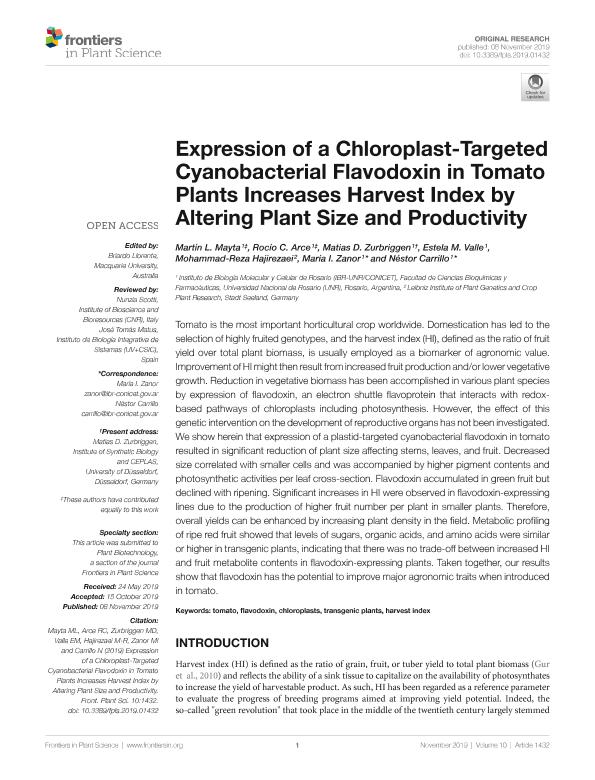Artículo
Expression of a Chloroplast-Targeted Cyanobacterial Flavodoxin in Tomato Plants Increases Harvest Index by Altering Plant Size and Productivity
Mayta, Martín Leonardo ; Arce, Rocio Cecilia
; Arce, Rocio Cecilia ; Zurbriggen, Matias Daniel
; Zurbriggen, Matias Daniel ; Valle, Estela Marta
; Valle, Estela Marta ; Hajirezaei, Mohammad Reza; Zanor, María Inés
; Hajirezaei, Mohammad Reza; Zanor, María Inés ; Carrillo, Nestor Jose
; Carrillo, Nestor Jose
 ; Arce, Rocio Cecilia
; Arce, Rocio Cecilia ; Zurbriggen, Matias Daniel
; Zurbriggen, Matias Daniel ; Valle, Estela Marta
; Valle, Estela Marta ; Hajirezaei, Mohammad Reza; Zanor, María Inés
; Hajirezaei, Mohammad Reza; Zanor, María Inés ; Carrillo, Nestor Jose
; Carrillo, Nestor Jose
Fecha de publicación:
11/2019
Editorial:
Frontiers Media
Revista:
Frontiers in Plant Science
e-ISSN:
1664-462X
Idioma:
Inglés
Tipo de recurso:
Artículo publicado
Clasificación temática:
Resumen
Tomato is the most important horticultural crop worldwide. Domestication has led to the selection of highly fruited genotypes, and the harvest index (HI), defined as the ratio of fruit yield over total plant biomass, is usually employed as a biomarker of agronomic value. Improvement of HI might then result from increased fruit production and/or lower vegetative growth. Reduction in vegetative biomass has been accomplished in various plant species by expression of flavodoxin, an electron shuttle flavoprotein that interacts with redox-based pathways of chloroplasts including photosynthesis. However, the effect of this genetic intervention on the development of reproductive organs has not been investigated. We show herein that expression of a plastid-targeted cyanobacterial flavodoxin in tomato resulted in significant reduction of plant size affecting stems, leaves, and fruit. Decreased size correlated with smaller cells and was accompanied by higher pigment contents and photosynthetic activities per leaf cross-section. Flavodoxin accumulated in green fruit but declined with ripening. Significant increases in HI were observed in flavodoxin-expressing lines due to the production of higher fruit number per plant in smaller plants. Therefore, overall yields can be enhanced by increasing plant density in the field. Metabolic profiling of ripe red fruit showed that levels of sugars, organic acids, and amino acids were similar or higher in transgenic plants, indicating that there was no trade-off between increased HI and fruit metabolite contents in flavodoxin-expressing plants. Taken together, our results show that flavodoxin has the potential to improve major agronomic traits when introduced in tomato.
Palabras clave:
CHLOROPLASTS
,
FLAVODOXIN
,
HARVEST INDEX
,
TOMATO
,
TRANSGENIC PLANTS
Archivos asociados
Licencia
Identificadores
Colecciones
Articulos(IBR)
Articulos de INST.DE BIOLOGIA MOLECULAR Y CELULAR DE ROSARIO
Articulos de INST.DE BIOLOGIA MOLECULAR Y CELULAR DE ROSARIO
Citación
Mayta, Martín Leonardo; Arce, Rocio Cecilia; Zurbriggen, Matias Daniel; Valle, Estela Marta; Hajirezaei, Mohammad Reza; et al.; Expression of a Chloroplast-Targeted Cyanobacterial Flavodoxin in Tomato Plants Increases Harvest Index by Altering Plant Size and Productivity; Frontiers Media; Frontiers in Plant Science; 10; 1432; 11-2019; 1-13
Compartir
Altmétricas



